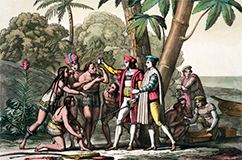Ancient genome study identifies traces of indigenous “Taíno” in present-day Caribbean populations
A thousand-year-old tooth has provided genetic evidence that the so-called “Taíno”, the first indigenous Americans to feel the full impact of European colonisation after Columbus arrived in the New World, still have living descendants in the Caribbean today.The study was carried out by an international team of researchers led by Dr Hannes Schroeder and Professor Eske Willerslev from the Natural History Museum of Denmark, University of Copenhagen, within the framework of the ERC Synergy project NEXUS1492. The findings are published in the journal Proceedings of the National Academy of Sciences (PNAS).
Researchers were able to use the tooth of a woman found in a cave on the island of Eleuthera in the Bahamas to sequence the first complete ancient human genome from the Caribbean. The woman lived at some point between the 8th and 10th centuries, at least 500 years before Columbus made landfall in the Bahamas.
The results provide unprecedented insights into the genetic makeup of the Taíno – a label commonly used to describe the indigenous people of that region. This includes the first clear evidence that there has been some degree of continuity between the indigenous peoples of the Caribbean and contemporary communities living in the region today.

First encounter. Columbus landing in the New World (Image courtesy of Library of Congress).
Concrete proof
Such a link had previously been suggested by other studies based on modern DNA. None of these, however, was able to draw on an ancient genome. The new research finally provides concrete proof that indigenous ancestry in the region has survived to the present day.
Comparing the ancient Bahamian genome to those of contemporary Puerto Ricans, the researchers found that they were more closely related to the ancient Taíno than any other indigenous group in the Americas. However, they argue that this characteristic is unlikely to be exclusive to Puerto Ricans alone and are convinced that future studies will reveal similar genetic legacies in other Caribbean communities.
Countering traditional historical narratives
The findings are likely to be especially significant for people in the Caribbean and elsewhere who have long claimed indigenous Taíno heritage, despite some historical narratives that inaccurately brand them “extinct”. Such misrepresentations have been heavily criticised by historians and archaeologists, as well as by descendant communities themselves, but until now they lacked clear genetic evidence to support their case.
The study was carried out by an international team of researchers led by Dr Hannes Schroeder and Professor Eske Willerslev from the Natural History Museum of Denmark, University of Copenhagen, within the framework of the ERC Synergy project NEXUS1492. The findings are published in the journal Proceedings of the National Academy of Sciences (PNAS).
Lead author Schroeder, from the University of Copenhagen who carried out the research as part of the NEXUS1492 project, said:
- It’s a fascinating finding. Many history books will tell you that the indigenous population of the Caribbean was all but wiped out, but people who self-identify as Taíno have always argued for continuity. Now we know they were right all along: there has been some form of genetic continuity in the Caribbean.
Related News
Contact
Dr. Hannes Schroeder
CITIGEN
Natural History Museum of Denmark
University of Copenhagen
Tel: +45 35 32 13 46 (office)
Mobile: +45 42 52 36 14
Mail: hschroeder@snm.ku.dk
